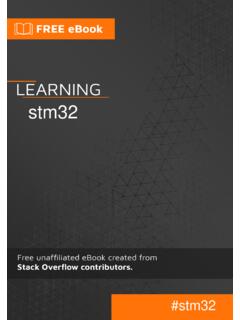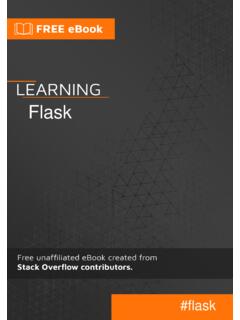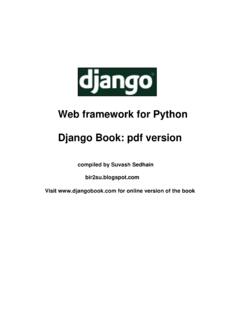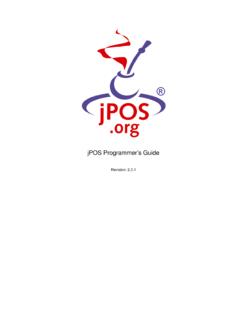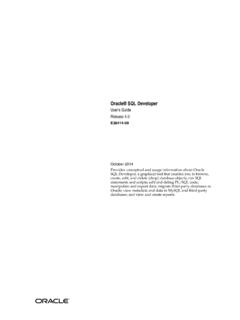Transcription of MongoDB
1 MongoDB #mongodbTable of ContentsAbout1 Chapter 1: getting started with MongoDB2 Remarks2 Versions2 Examples3 Installation3 Hello World6 Complementary Terms6 Execution of a JavaScript file in MongoDB7 Making the output of find readable in shell7 Basic commands on mongo shell8 Chapter 2: 2dsphere Index9 Examples9 Create a 2dsphere Index9 Chapter 3: Aggregation10 Introduction10 Syntax10 Parameters10 Remarks10 Examples10 Count10 Sum11 Average12 Operations with docs that have a duplicate field in a collection (dedupe)14 Chapter 4: Authentication Mechanisms in MongoDB15 Introduction15 Examples15 Authentication Mechanisms15 Chapter 5: Backing up and Restoring Data16 Examples16mongoimport with JSON16mongoimport with CSV16 Chapter 6: Backing up and Restoring Data18 Examples18 Basic mongodump of local default mongod instance18 Basic mongorestore of local default mongod dump18 Chapter 7: Bulk Operations19 Remarks19 Examples19 Converting a field to another type and updating the entire collection in Bulk19 Chapter 8: Collections22 Remarks22 Examples22 Create a Collection22 Drop Collection23 Chapter 9.
2 Configuration24 Parameters24 Examples26 Starting mongo with a specific config file26 Chapter 10: CRUD Operation27 Syntax27 Remarks27 Examples27 Create27 Update28 Delete28 Read29 More update operators30"multi" Parameter while updating multiple documents30 Update of embedded 11: getting database information32 Examples32 List all databases32 List all collections in database32 Chapter 12: Indexes33 Syntax33 Remarks33 Examples33 Single field33 Compound33 Delete33 List34 Index Creation Basics34 Hashed indexes36 Dropping/Deleting an Index36 Get Indices of a Collection37 Unique Index37 Sparse indexes and Partial indexes37 Chapter 13: Java Driver39 Examples39 Create a tailable cursor39 Create a database user39 Fetch Collection data with condition39 Chapter 14: Managing MongoDB41 Examples41 Listing currently running queries41 Chapter 15: Mongo as a Replica Set42 Examples42 MongoDB as a Replica Set42 Chapter 16.
3 Mongo as a Replica Set44 Examples44 Check MongoDB Replica Set states44 Chapter 17: Mongo as Shards46 Examples46 Sharding Environment Setup46 Chapter 18: MongoDB - Configure a ReplicaSet to support TLS/SSL48 Introduction48 Examples48 How to configure a ReplicaSet to support TLS/SSL?48 Create the Root Certificate48 Generate the Certificate Requests and the Private Keys48 Sign your Certificate Requests49 Concat each Node Certificate with its key49 Deploy your ReplicaSet50 Deploy your ReplicaSet for Mutual SSL / Mutual Trust50 How to connect your Client (Mongo Shell) to a ReplicaSet?50No Mutual SSL50 With Mutual SSL51 Chapter 19: MongoDB Aggregation53 Examples53 Aggregate query examples useful for work and learning53 Java and Spring example57 Get sample data58 Left Outer Join with aggregation ( $Lookup)58 Chapter 20: MongoDB Authorization Model60 Introduction60 Examples60 Build-in Roles60 Chapter 21: Pluggable Storage Engines61 Remarks61 Examples61 MMAP61 WiredTiger61 How to use WiredTiger Engine61In-memory62mongo-rocks62 Fusion-io62 TokuMX62 Chapter 22.
4 Python Driver63 Syntax63 Parameters63 Examples63 Connect to MongoDB using pymongo63 PyMongo queries63 Update all documents in a collection using PyMongo64 Chapter 23: Querying for Data ( getting started )65 Introduction65 Examples65 Find()65 FindOne()65 Query Document - Using AND, OR and IN Conditions66find() method with Projection68 Find() method with Projection68limit, skip, sort and count the results of the find() method69 Chapter 24: Replication71 Examples71 Basic configuration with three nodes71 Chapter 25: Update Operators73 Syntax73 Parameters73 Remarks73 Examples73$set operator to update specified field(s) in document(s) happen if we don't use update operators?
5 73 III.$set operator74 Chapter 26: Upgrading MongoDB version76 Introduction76 Remarks76 Examples76 Upgrading to on Ubuntu using apt76 Chapter 27: Upserts and Inserts77 Examples77 Insert a document77 Credits78 AboutYou can share this PDF with anyone you feel could benefit from it, downloaded the latest version from: mongodbIt is an unofficial and free MongoDB ebook created for educational purposes. All the content is extracted from Stack Overflow Documentation, which is written by many hardworking individuals at Stack Overflow. It is neither affiliated with Stack Overflow nor official content is released under Creative Commons BY-SA, and the list of contributors to each chapter are provided in the credits section at the end of this book.
6 Images may be copyright of their respective owners unless otherwise specified. All trademarks and registered trademarks are the property of their respective company the content presented in this book at your own risk; it is not guaranteed to be correct nor accurate, please send your feedback and corrections to 1: getting started with MongoDBRemarksData in the world started to grow tremendously after mobile application came in the market. This huge amount of data became almost impossible to handle with traditional relational database - SQL. NoSQL databases are introduced to handle those data where much more flexibility came like variable number of columns for each data.
7 MongoDB is one of the leading NoSQL databases. Each collection contains a number of JSON documents. Any data model that can be expressed in a JSON document can be easily stored in MongoDB . MongoDB is a server-client database . Server usually runs with the binary file mongod and client runs with mongo. There is no join operation in MongoDB prior to , for various philosophical and pragmatic reasons. But Mongo shell supports javascript, so if $lookup is not available, one can simulate join operations on documents in javascript before inserting. To run an instance in production environment, it's strongly advised to follow the Operations Checklist.
8 VersionsVersionRelease install MongoDB , follow the steps below:For Mac OS:There are two options for Mac OS: manual install or homebrew. Installing with homebrew:Type the following command into the terminal:$ brew install MongoDB Installing manually:Download the latest release here. Make sure that you are downloading the appropriate file, specially check whether your operating system type is 32-bit or 64-bit. The downloaded file is in format tgz. Go to the directory where this file is downloaded. Then type the following command:$ tar xvf of xyz, there would be some version and system type information.
9 The extracted folder would be same name as the tgz file. Inside the folder, their would be a subfolder named bin which would contain several binary file along with mongod and mongo. By default server keeps data in folder /data/db. So, we have to create that directory and then run the server having the following commands:$ sudo bash # mkdir -p /data/db # chmod 777 /data # chmod 777 /data/db # exit To start the server, the following command should be given from the current location:$ ./mongodIt would start the server on port 27017 by default. To start the client, a new terminal should be opened having the same directory as before.
10 Then the following command would start the client and connect to the $ ./mongoBy default it connects to the test database . If you see the line like connecting to: test. Then you have successfully installed MongoDB . Congrats! Now, you can test Hello World to be more Windows:Download the latest release here. Make sure that you are downloading the appropriate file, specially check whether your operating system type is 32-bit or 64-bit. The downloaded binary file has extension exe. Run it. It will prompt an installation wizard. Click Next. Accept the licence agreement and click Next. Select Complete Installation.


